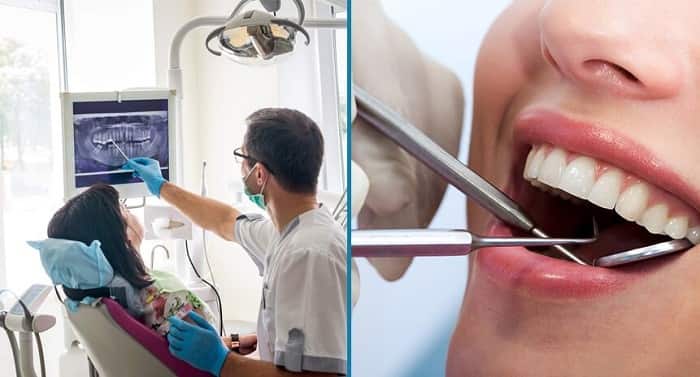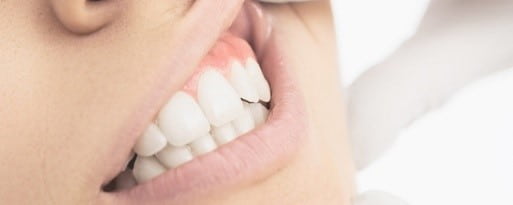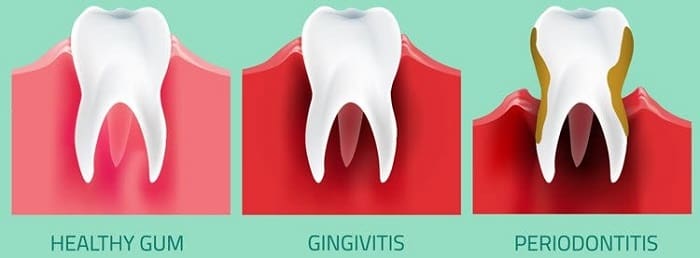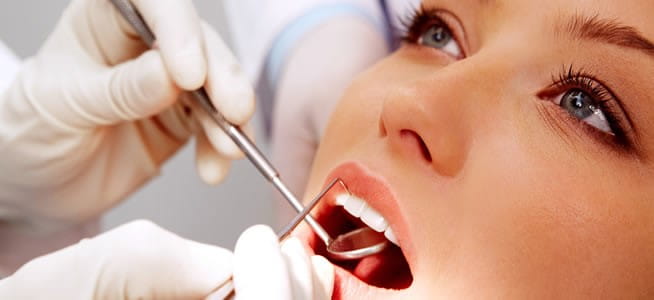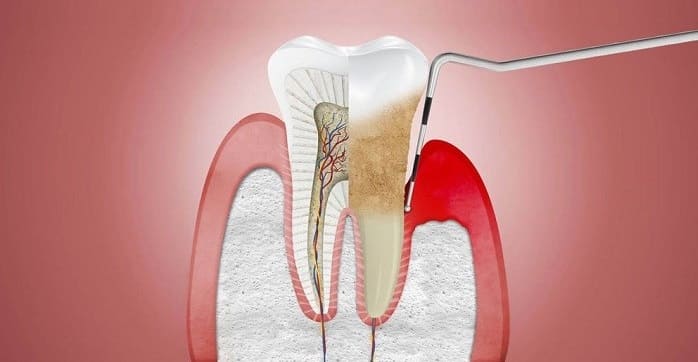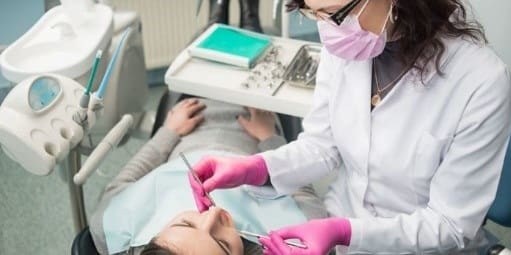Periodontics is the dental specialty focusing exclusively in the inflammatory disease that destroys the gums and other supporting structures around the teeth. A periodontist is a dentist who specializes in the prevention, diagnosis, and treatment of periodontal, or disease, and in the placement of dental implants. Periodontists receive extensive training in these areas, including three additional years of education beyond dental school. As specialists in periodontal disease, they are experts in the latest techniques for diagnosing and treating periodontal disease. They are also trained in cosmetic periodontal procedures.
Gum disease will continue to worsen when left untreated. Laguna Niguel Periodontists will help patients to improve their gum health and to avoid re-infection with various gum disease treatments.
What are the symptoms of gum disease?
Gum disease is an ongoing infection in the gums, which can lead to bone and tooth loss. It can sometimes be silent, meaning there are no symptoms present.
Check your gums on a regular basis for these signs of gum disease:
- a change in the colour of your gums
- gums that are red around your teeth
- gums that bleed every time you brush or floss
- bad breath that will not go away
- a taste of metal in your mouth
- shiny, puffy or sore gums
- teeth that are sensitive for no reason
These are all good reasons to see periodentist right away. Gum disease is one of the main reasons why adults lose their teeth. But the good news is gum disease can almost always be prevented. If it starts, it can be treated and can even be turned around (or reversed) in its early stages.
If gum disease is not treated, you can have gums that are always sore, red and puffy, get a painful infection (called an abscess) in the area between your teeth and gums or lose your teeth.
Without enough gum tissue and bone to hold your teeth in place, they can become loose and fall out. Nobody wants to have these things happen. With regular care, they won’t.
What are the stages of periodontal disease?
It’s important to understand that periodontal disease can lead to significant health problems when left untreated. Undergoing regular dental exams and routine dental cleanings help to identify periodontal disease early on. Gum disease can be reversed when it is caught in the gingivitis stage. There are four stages of periodontal disease that range from mild to advanced:
- Gingivitis: The first phase of periodontal disease is caused by plaque buildup at or around the gumline. When left untreated, it can develop into the next phase. This is is the only stage that is reversible since it hasn’t attacked bones yet.
- Slight Periodontal Disease: The second stage of periodontal disease affects both the bone and fibers that support tooth roots. Once stage two is reached, the infection has spread into the bone and begun to destroy it. Scaling and root planing can be used to deep clean the teeth gums at this stage.
- Moderate Periodontal Disease: This third stage has deeper periodontal pockets, which allows bacteria to attack the bones and bloodstream more aggressively. Our professional periodontal team can thoroughly clean the area with gum disease treatment.
- Advanced Periodontal Disease: The final stage of periodontal disease is when bacteria have significantly deteriorated the bone that supports the teeth. This stage requires laser therapy or periodontal surgery. It is used to clean deep bacteria-filled pockets. If left untreated, stage four can lead to gaps between the teeth, significant gum recession, the need for dentures, and serious health problems.
Treating periodontal disease quickly is important. Laguna Niguel Periodontists provide a series of gum disease treatments for patients with gum disease.
WHO SHOULD SEE A PERIODONTIST?
Some patients’ periodontal needs can be managed by the general dentist. However, as more and more patients are exhibiting signs of periodontal disease, coupled with research that suggests a relationship between periodontal disease and other chronic diseases of aging, periodontal treatment may necessitate a greater understanding and increased level of expertise by a trained specialist. Patients who present with moderate or severe levels of periodontal disease, or patients with more complex cases, will be best managed by a partnership between the dentist and periodontist.
A periodontist is a dentist who specializes in the prevention, diagnosis, and treatment of periodontal disease, and in the placement of dental implants. Periodontists are also experts in the treatment of oral inflammation. Periodontists receive extensive training in these areas, including three additional years of education beyond dental school. They are familiar with the latest techniques for diagnosing and treating periodontal disease, and are also trained in performing cosmetic periodontal procedures.
Periodontists often treat more problematic periodontal cases, such as those with severe gum disease or a complex medical history. Periodontists offer a wide range of treatments, such as scaling and root planing (in which the infected surface of the root is cleaned) or root surface debridement (in which damaged tissue is removed). They can also treat patients with severe gum problems using a range of surgical procedures. In addition, periodontists are specially trained in the placement, maintenance, and repair of dental implants.
During the first visit, the periodontist usually reviews the patient’s complete medical and dental histories. It is extremely important for the periodontist to know if any medications are being taken or if the patient is being treated for any condition that can affect periodontal care, such as heart disease, diabetes, or pregnancy.
The periodontist examines the gums, checks to see if there is any gum line recession, assesses how the teeth fit together when biting, and checks the teeth to see if any are loose. The periodontist will also take a small measuring instrument called a probe and place it between the teeth and gums to determine the depth of those spaces, known as periodontal pockets; this helps the periodontist assess the health of the gums. X-rays may also be taken to observe the health of the bone below the gum line.
Gum disease treatments
The gum disease treatment option Laguna Niguel Periodontists choose for patients will depend on the severity of the progression of the disease in their gums. Some of the most common periodontal treatments that Periodontists use include:
- Dental cleanings: During a routine dental cleaning, Periodontists remove plaque and tartar from above and below the gumline. If doctors suspect a patient has gum disease, they will recommend more frequent dental cleanings.
- Scaling and root planing: Scaling and root planing is a deep-cleaning and nonsurgical procedure done under local anesthesia. Plaque and tartar are scraped away from both above and below the gumline. Rough spots on the tooth root are made smooth with planing by our periodontist. Smoothing these rough spots helps to remove bacteria and provides a clean surface for the gum to reattach to the teeth.
- Flap surgery/pocket reduction surgery: For more advanced stages of periodontal disease, surgery may be required. During this surgery, the gums are lifted and tartar is removed. Irregular surfaces of a damaged bone can also be smoothed where disease-causing bacteria may be hiding. After this is performed, the gums are then placed so that tissue fits snugly around the tooth. This will reduce the space between the gum and tooth, which reduces the chance of bacteria from spreading again.
- Bone grafts: This uses fragments of a patient’s own bone, donated bone, or synthetic bone to replace bone that has been destroyed by gum disease. This promotes regrowth of bone, which helps to make the teeth more stable. Soft tissue grafts are also used to fill in places where gum recession may have occurred.
- LANAP® laser gum surgery: Laguna Niguel Periodontists may choose this gum disease treatment for patients who may not be able to endure the alternative surgery. It is less invasive, requires little to no downtime, and reduces the chance of tooth sensitivity post-op.
Post-Op Instructions
Diet
Do not eat for about 3 hours following the surgery. Then, a soft or liquid diet, including warm soup or instant breakfast, is advised for the next 2-3 days. Avoid alcohol, carbonated drinks, and hard, brittle foods such as tortilla chips that can injure the surgical site. Drinking plenty of fluids and eating a well balanced diet is important to your recovery.
Medications
Moderate discomfort may begin as the anesthesia wears off. A non-aspirin analgesic may be recommended to relieve any tenderness or discomfort, and may be taken within the first hour after surgery. It is important to take the prescribed antibiotic as it will aid in the healing process. If you have a reaction to a medication such as nausea, or skin rash, stop taking it immediately and call office.
Bleeding Control
Slight bleeding or oozing after the surgery is normal and may occur at intervals for the first 24-48 hours. Forceful rinsing or excessive spitting can disrupt clotting, so do not rinse for at least 4 hours. If bleeding does persist:
- Apply a moistened gauze pad, or tea bag, with moderate pressure to the bleeding site for 20 minutes. Repeat, if necessary.
- Stay calm and quiet; lie down with the head elevated on 2-3 pillows.
- If the bleeding persists do not hesitate to call office.
Swelling
Slight swelling is a common response in the healing process. To minimize excessive swelling, place an ice bag or a cold, moist compress over the involved site for 10-20 minute intervals. Repeat this several times as needed over the next 48 hours. If the swelling increases or discomfort develops, again, call office.
Oral Hygiene
It is extremely important to keep your teeth and gums clean following surgery. Not only will this will help to achieve a better result, but the tissues will heal faster. Brush your teeth very lightly the first night. Then begin flossing the next day, allowing the floss to very gently touch the gums of the surgical area. Do not force the floss vigorously between the tooth and the gums as this will prevent the new attachment from developing normally. Also, refrain from using any irrigation devices such as the Water Pik. After brushing and flossing, apply chlorhexidine gluconate (Peridex), if prescribed, with a cotton swab first by dabbing the area lightly, and then gently swishing a capful in the mouth for 30 seconds. Avoid using any strong mouthwashes that contain alcohol.
No Smoking
Do not smoke for at least 48 hours. Smoking can seriously delay the healing process. If you have any questions or problems, please call office.

